The first raid on Tokyo was the Doolittle Raid of April 18, 1942, when sixteen B-25 Mitchells were launched from the USS Hornet to attack targets including Yokohama and Tokyo and then fly on to airfields in China. The raid did no damage to Japan's war capability but was a significant propaganda victory for the United States. Launched prematurely, none of the attacking aircraft reached the designated airfields, either crashing or ditching (except for one aircraft which landed in the Soviet Union, where the crew was interned). Two crews were captured by the Japanese.
B-29 raids
The key development for the bombing of Japan was the B-29, which had an operational range of 3,250 nautical miles (6,019 km); almost 90% of the bombs dropped on the home islands of Japan were delivered by this type of bomber. The initial raids were carried out by the Twentieth Air Force operating out of mainland China in Operation Matterhorn under XX Bomber Command but was supplemented in November 1944 by the activation of XXI Bomber Command based in the Northern Mariana Islands. The B-29s of XX Bomber Command were transferred to XXI Bomber Command in the spring of 1945 and based on Guam.
The first raid using low-flying B-29s carrying incendiaries to drop on Tokyo was on the night of February 24-25 1945 when 174 B-29s destroyed around one square mile (3 km²) of the city.
Changing their tactics to expand the coverage and increase the damage, 279 B-29s raided on the night of March 9–10, dropping around 1,700 tons of bombs. Approximately 16 square miles (41 km²) of the city were destroyed and some 100,000 people are estimated to have died in the resulting firestorm, more than the immediate deaths of either Hiroshima or Nagasaki.[1][2] The US Strategic Bombing Survey later estimated that nearly 88,000 people died in this one raid, 41,000 were injured, and over a million residents lost their homes. The Tokyo Fire Department estimated a higher toll: 97,000 killed and 125,000 wounded. The Tokyo Metropolitan Police Department established a figure of 124,711 casualties including both killed and wounded and 286,358 buildings and homes destroyed. Richard Rhodes, historian, put deaths at over 100,000, injuries at a million and homeless residents at a million. These casualty and damage figures could be low: Mark Selden wrote in Japan Focus
The figure of roughly 100,000 deaths, provided by Japanese and American authorities, both of whom may have had reasons of their own for minimizing the death toll, seems to me arguably low in light of population density, wind conditions, and survivors' accounts. With an average of 103,000 inhabitants per square mile and peak levels as high as 135,000 per square mile, the highest density of any industrial city in the world, and with firefighting measures ludicrously inadequate to the task, 15.8 square miles (41 km²) of Tokyo were destroyed on a night when fierce winds whipped the flames and walls of fire blocked tens of thousands fleeing for their lives. An estimated 1.5 million people lived in the burned out areas.[3]
The destruction and damage was at its worst in the city sections east of the Imperial Palace.
Over 50% of Tokyo would be destroyed by the end of World War Two.
B-29 missions against Tokyo
Additional missions against Tokyo targets were carried out by twin-engine bombers and by fighter-bombers.[5]
Aftermath
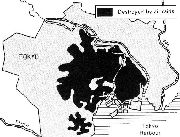
Damage to Tokyo's heavy industry was slight until firebombing destroyed much of the light industry that was used as an integral source for small machine parts and time-intensive processes. Firebombing also killed and made homeless many workers who had been taking part in war industry. Over 50% of Tokyo's industry was spread out among residential and commercial neighborhoods; firebombing cut their output in half.
Emperor Hirohito's viewing of the destroyed areas of Tokyo in March, 1945, is said to have been the beginning of his personal involvement in the peace process, culminating in Japan's surrender five months later.[6]
After the war, Tokyo would struggle to rebuild. In 1945/1946, the city received a share of the national reconstruction budget roughly proportional to its amount of bombing damage (26.6%), but in successive years Tokyo saw its share dwindle. By 1949, Tokyo was given only 10.9% of the budget; at the same time there was runaway inflation devaluing those monies as Japan was spending more than it was bringing in from taxes. Occupation authorities such as Joseph Dodge stepped in and drastically cut back on Japanese government rebuilding programs, focusing instead on simply improving roads and transportation. Tokyo would not experience fast economic growth until the 1950s.[7]
Unexploded U.S. bombs were still being found and recovered in Tokyo as late as 2008.[8]
See also
References
Notes
Books
External links
| |||||||||||
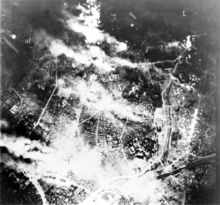
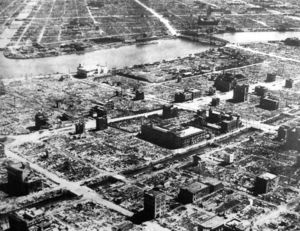
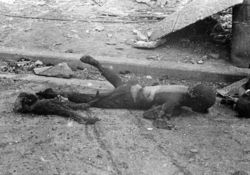

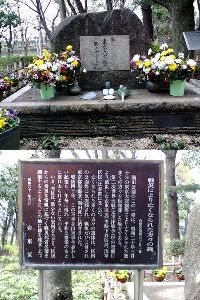


No comments:
Post a Comment